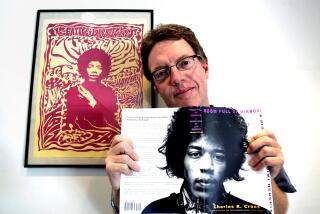Grunge Rock’s Kurt Cobain Dies in Apparent Suicide : Tragedy: A shotgun blast to the head claims leader of Nirvana. He was seen as voice of a generation adrift.
SEATTLE — Kurt Cobain, who with his band Nirvana shaped modern rock music from the restless alienation of today’s youth, was found dead Friday, an apparent suicide from a shotgun blast to the head. He was 27.
Cobain’s body was found about 8:30 a.m. by an electrician at the musician’s Seattle home. Authorities said he had been dead about a day; the Seattle medical examiner confirmed Cobain’s death.
A single-page suicide note was found next to the body. Authorities would not release its contents, but the electrician, in an interview with KNBC-TV news, said that the note was covered in dirt from a potted plant and written in ballpoint pen--ending with the words: “I love you, I love you.”
Almost immediately after learning of Cobain’s death, fans in this town--which he helped propel into the vanguard of ‘90s rock ‘n’ roll--gathered outside the home to mourn. A steady drizzle fell from chilly gray skies.
Cobain’s death came while he was struggling with drug use and the kind of deep, personal turmoil that made his music so gripping to his generation. Just last month, Cobain was hospitalized in Rome in a drug-and-alcohol induced coma. And this week Nirvana pulled out of a headliner’s spot in the upcoming national “Lollapalooza ‘94” tour amid reports that the band was breaking up and concerns about his health.
With his shaggy blond hair and slight physique, Cobain brought his style of edgy, blasting, rock known as grunge into the mainstream of pop music--and his influence spread into the trendy fashion of shabby flannel shirts and granny dresses.
By the end, he had come to define the very attitudes of the alienated young and was acclaimed as the voice of a generation adrift.
Perhaps the band was best known for its 1991 album “Nevermind” and the sarcastic anthem “Smells like Teen Spirit.” The album sold 10 million copies worldwide. The follow-up album, 1993’s “In Utero,” also was a critical and commercial hit.
Capitol Records CEO Gary Gersh--who signed Cobain’s trio to Geffen Records during his tenure there in the late 1980s as an artist and repertoire executive--said he was stunned.
“This is a terribly sad day for the music industry,” said Gersh, who guided the recording and release of “Nevermind” and has known Cobain since 1988.
“When people look back over the years at the industry, I believe there will be a pre-Nirvana business and a post-Nirvana business. The group’s ‘Nevermind’ album will be looked back on as a seminal record in the history of rock.”
Word of Cobain’s death first spread Friday morning when the electrician called a local radio station and described showing up at the musician’s wooded home to work on a security system. The electrician said he looked into the large glass windows of a cottage above a detached garage and saw a body. He called police and then the radio station.
Later, a statement from the King County medical examiner’s office said, in part, “An autopsy has shown Kurt Cobain died of a shotgun wound to the head and at this time the wound appears to be self-inflicted.”
Cobain previously had admitted difficulties with heroin use, but insisted he conquered them in 1992 after he and his wife, rock singer Courtney Love, became the parents of a girl, Frances Bean Cobain.
But rumors of periodic relapses persisted. Then last month in Rome, the singer was hospitalized in a coma apparently brought on by mixing prescription sedatives and champagne. He recovered, but Nirvana’s successful European tour was in tatters.
There were rumors at the time that the episode was a suicide attempt, but they were dismissed as the ghoulish speculation that always seems to surround rock star tragedies.
Privately, however, those closest to the singer were deeply concerned. His condition was apparently so bad that sources said his friends confronted him about the problem and tried to persuade him to seek treatment. A few days later Cobain was believed to have entered a Los Angeles drug recovery program, but soon checked himself out.
Love, of the band Hole, was in Los Angeles when the body was found Friday and reportedly was being comforted by her attorney. She could not be reached for comment.
Cobain’s mother, Wendy O’Conner, told reporters from her home in Aberdeen, Wash., that she had not heard from the singer in six days and had been worried for his life. She said she warned him of the troubled lives and early deaths of rock stars. “I told him not to join that stupid club.”
His wife and management company had not known of his whereabouts for days, sources said.
Critics compared Cobain’s musical influence to that of Bob Dylan and John Lennon. On Friday, many here drew another tragic parallel--with the great guitarist and Seattle native Jimi Hendrix, who died at age 27 in a London flat in 1970, the result of a drug overdose.
Cobain put to music not the anti-Establishment rage of the ‘60s but the malaise of a ‘90s generation, many of them products of broken homes who were denied the promise of a better life and who found themselves questioning the meaning of life itself.
“Teen-age Angst has paid off well / Now I’m bored and old,” was the opening line of Nirvana’s last album.
Kurt Donald Cobain was a native of the rural logging community of Aberdeen, about 100 miles southwest of Seattle. Himself the product of a broken family, Cobain lived an unhappy, drifting childhood, experiences that when translated into music touched millions of youths like him.
In an interview Monday with The Times’ Robert Hilburn, Love tried to describe her husband’s lost youth.
“There is this sweet Jimmy Stewart, ‘Mayberry, RFD’ side of him. His favorite TV shows are ‘Dragnet’ and ‘Mayberry, RFD’ and ‘Leave it to Beaver.’ To him they represent his lost boyhood,” she said. And she spoke of the future: “I’m just glad I had a girl, but I want to have a son with him too. Just so I can help him make up for the relationship he never had” with his father.
Thanks to Nirvana, followed by Pearl Jam and other Seattle bands, this city became the capital of contemporary rock, erasing the line between alternative and mainstream music and breathing new life into a style of music that had, in the eyes of many, gone flabby and commercial.
As a youth, Cobain told interviewers, he was influenced by the Beatles, then Led Zeppelin. It was the punk revolution of the late ‘70s and early ‘80s that proved to be the catalyst for his career. With another Aberdeen musician, bassist Krist Novoselic, Cobain formed Nirvana in 1986. Living on food stamps and working odd jobs, they joined with a series of drummers. Success was quick.
The group’s first album, “Bleach,” was released by Sub Pop, the groundbreaking label that was responsible for launching the Seattle sound. With drummer Dave Grohl, the group signed with Geffen Records’ DGC label in 1991.
In 1992, the group was recognized for best new artist and best alternative video at the MTV Video Music Awards. Four times Nirvana was nominated for Grammys but never won.
Cobain’s lyrics were sometimes sexual and often flirted with dark themes.
In the final chant of Nirvana’s most famous song, “Teen Spirit,” Cobain sings this: “With the lights out / It’s less dangerous. . . .”
Correspondents Steve Hochman and Chuck Philips in Los Angeles contributed to this story.
* RELATED STORY: F1
Deadly Fate
The mother of Kurt Cobain, troubled lead singer of the rock band Nirvana who apparently shot himself to death Friday, said she had told her son “not to join that stupid club” of rock stars who have died early, often because of drug or alcohol use. Some of those musicians are:
* Janis Joplin: A charismatic and influential performer, Joplin died in 1970 at age 27 of a drug overdose.
* Elvis Presley: Died in 1977 in Memphis, Tenn., at the age of 42 of an apparent overdose of prescription drugs. The cause of death was listed as heart failure.
* Jimi Hendrix: One of rock’s most important guitarists, died at age 27 in 1970 of a drug overdose.
* Donny Hathaway: The singer and songwriter fell to his death from the 15th floor of a Manhattan hotel in an apparent suicide in 1979 at the age of 33.
* Jim Morrison: Lead singer for the Doors, died in 1971 of an apparent heart attack in Paris. He was 27.
* Sid Vicious: Bassist for the punk-rock band the Sex Pistols, died of a heroin overdose in 1979 at the age of 21.
More to Read
The biggest entertainment stories
Get our big stories about Hollywood, film, television, music, arts, culture and more right in your inbox as soon as they publish.
You may occasionally receive promotional content from the Los Angeles Times.










